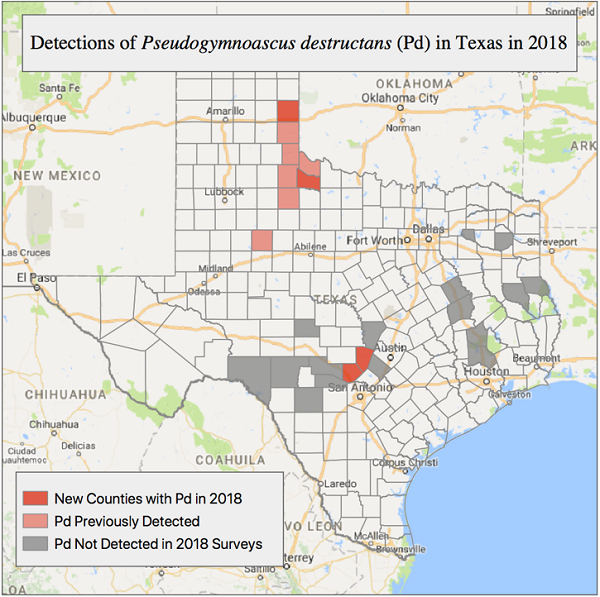Commission Agenda Item No. 12
Presenter:
Jonah Evans
Briefing
White-Nose Syndrome
August 23, 2018
I. Executive Summary: The fungus (Pseudogymnoascus destructans) that causes White-Nose Syndrome (WNS) in bats has spread into Central Texas. Texas Parks and Wildlife Department (TPWD) staff will present details of this discovery and discuss plans for moving forward.
II. Discussion: Since the discovery of WNS in New York State in 2006, it is estimated that over six million bats have perished as the disease has spread through the eastern United States and Canada. Texas Parks and Wildlife Department-funded research projects with Texas A&M University and Bat Conservation International detected the fungus in Texas for the first time in early 2017 in six Panhandle Counties. Surveys conducted this winter resulted in detections of the fungus in four additional counties: two sites in Blanco County, one site in Foard County, two sites in Kendall County, and one site in Wheeler County.
The fungus has now been detected in a total of ten Texas counties and on four bat species: tri-colored bat (Perimyotis subflavus), cave myotis (Myotis velifer), Townsend’s big-eared bat (Corynorhinus townsendii), and the Mexican free-tailed bat (Tadarida brasiliensis).
The detection of the fungus on a Mexican free-tailed bat was at Old Tunnel State Park in Kendall County. This is first-ever detection of the fungus on this species, which is known for drawing tourists to sites such as Austin’s Congress Avenue Bridge and the Bracken Bat Cave. While Mexican free-tailed bats are not expected to be susceptible to WNS, researchers are concerned because the bats migrate in large numbers and may help spread the disease further into the western United States or into Mexico. Kendall County is now the southernmost county with the fungus in the United States.
The severity of WNS varies among species. Of the 30 species of bats found in Texas, we anticipate up to 11 to be impacted by the disease. The remaining 19 species are not expected to be at risk.
TPWD is continuing to coordinate WNS monitoring around the state and is supporting efforts by Bat Conservation International to conduct experimental treatment trials at several Panhandle caves. Additionally, TPWD is planning to apply experimental treatments at several sites this winter in an attempt to reduce expected WNS-related mortality.
Commission Agenda Item No. 12
Exhibit A
Map of Pseudogymnoascus destructans detections in Texas
